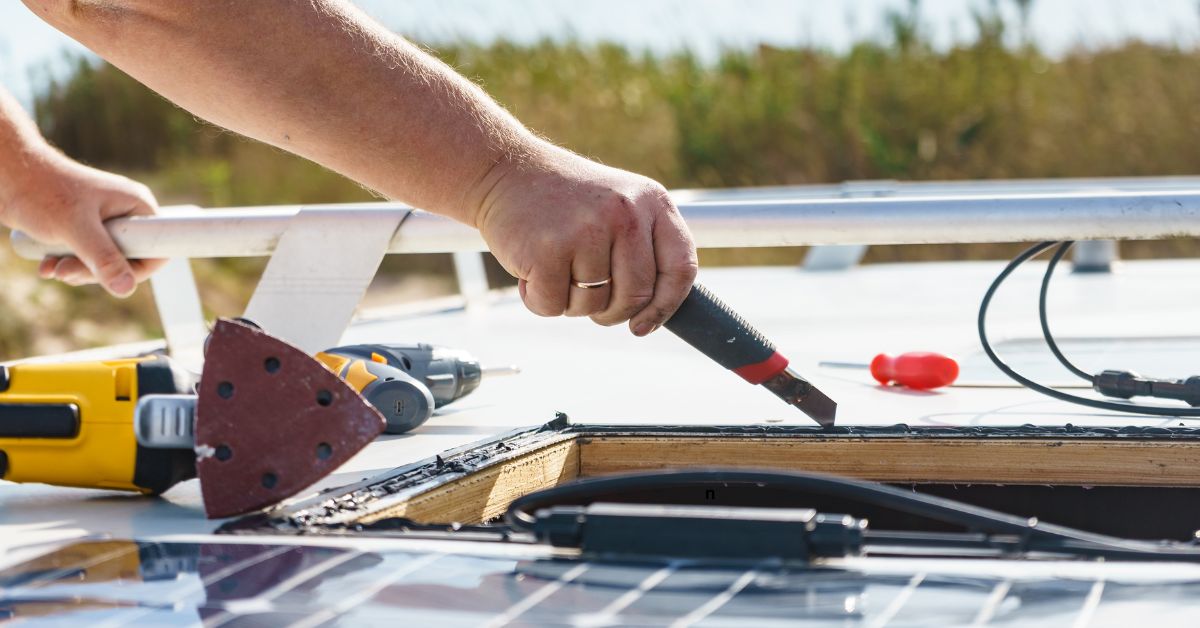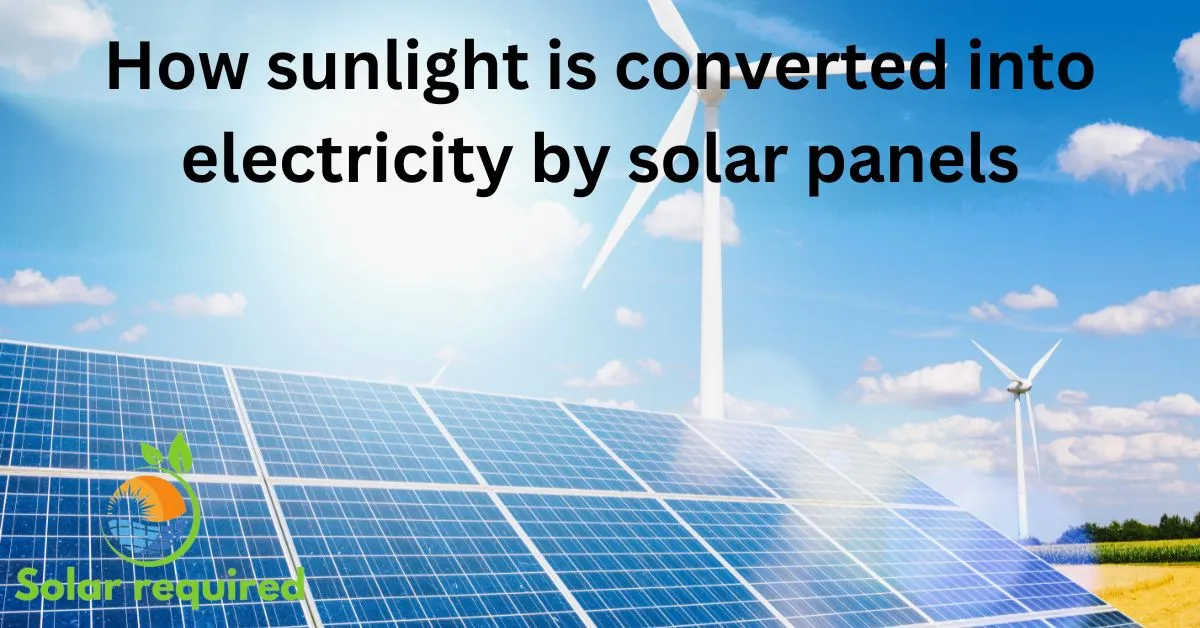Understanding how to manage battery disconnect with solar panel settings is key. It helps make your system work better and stay safe. This guide will show you how to set up your solar energy storage right.
You can make your solar panels last longer by learning how to handle battery disconnects. This is important for keeping your energy storage solutions working well. Let’s explore how to set up your battery settings for the best results.
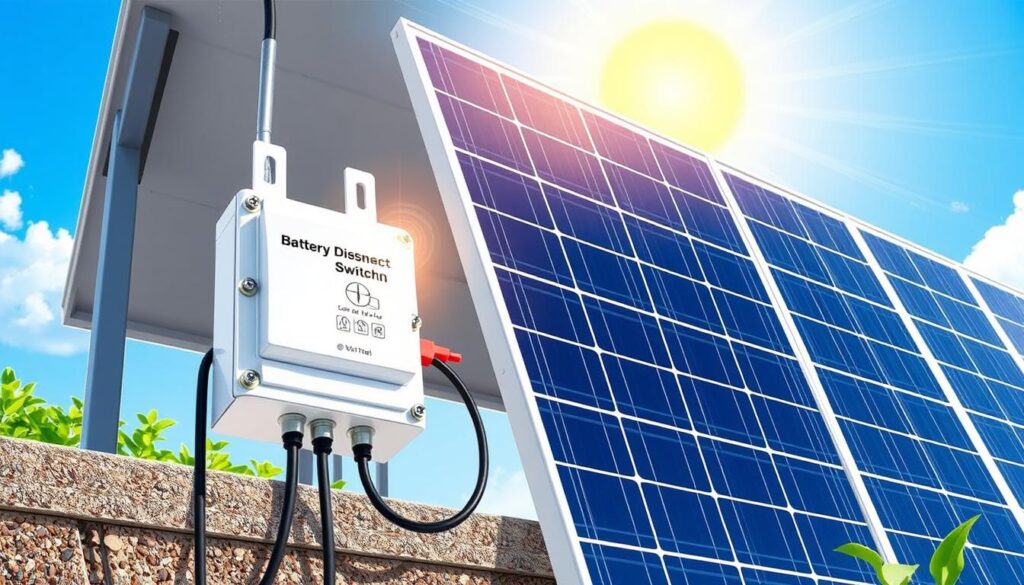
Key Takeaways
- Understanding battery disconnect settings is vital for solar system efficiency.
- Proper management of battery disconnects extends the lifespan of solar energy storage.
- Optimized settings improve safety during system maintenance.
- Efficient energy management supports sustainable practices.
- Familiarity with your solar setup guarantees effective troubleshooting.
Check: Solar Panel Roof Requirements: What You Need to Know
Understanding Solar Panel Systems
Solar panel systems are key parts of renewable energy. They use sunlight to make power. At the center are photovoltaic systems, which turn sunlight into electricity. Knowing the parts of solar panel setups helps us see how energy is gathered, changed, stored, and used.
Several important parts are involved in installing solar panels. These include solar panels, inverters, batteries, and monitoring systems. Solar panels, made of many solar cells, catch sunlight and create electric currents. Inverters then change this direct current (DC) into alternating current (AC), making it good for home use.
There are various solar energy systems, like grid-tied and off-grid ones. Grid-tied systems link directly to the public electricity grid. They let homeowners use grid power when solar panels can’t meet their needs. Off-grid systems work alone, using stored energy from batteries after being changed by inverters. They’re great for places far from the grid.
When picking solar panel systems, it’s important to think about energy needs and local conditions. Things like roof direction and shade can affect how well solar panels work. By looking at these factors, homeowners can pick the best setup to get the most energy. Knowing how these systems work is key to making smart choices about solar energy.
The Importance of Battery Disconnect Settings
Battery disconnect settings are key in solar panel systems. They play a big role in keeping batteries safe during maintenance and emergencies. It’s important to set them upright to avoid damage and risks.
Ignoring these settings can cause big problems. It might lead to equipment failure and safety hazards. Making sure batteries are disconnected properly helps keep the system safe and working well.
Knowing how to set up battery disconnects is crucial. It keeps people safe and protects investments in solar energy. With more people using solar power, learning about these settings is more important than ever.
| Consequences of Improper Settings | Safety Risks | Preventive Measures |
|---|---|---|
| Overcharging | Fire hazards | Regular maintenance checks |
| Equipment damage | Battery leakage | Installation of disconnect switches |
| System inefficiency | Electric shock | Consultation from certified technicians |
Battery Disconnect with Solar Panel Settings
A battery disconnect is key in managing solar energy systems. It isolates the battery from the solar array, ensuring safety and efficiency. Knowing about different disconnect switches helps manage batteries better and extends their life. Installing a battery isolator correctly makes this easier.
What is a Battery Disconnect?
A battery disconnect is a switch that turns off battery power from the solar system. It’s crucial for managing deep-cycle batteries, reducing wear during maintenance, and protecting against hazards. There are manual and automatic disconnect switches, each for different needs.
When Should You Disconnect Your Battery?
Disconnection is needed in certain situations for safety and system integrity. These include:
- Performing routine maintenance on the solar system.
- Addressing emergencies like battery swelling or leakage.
- Monitoring weather conditions, such as severe storms, that could disrupt performance.
Disconnecting at the right time ensures the best management of deep-cycle batteries. This protects the battery and other components. Knowing when to disconnect helps keep your solar energy system healthy.
| Situation | Action |
|---|---|
| Routine Maintenance | Disconnect the battery to ensure safety. |
| Emergency Scenario | Immediately disconnect to prevent hazards. |
| Severe Weather | Disconnect to safeguard system components. |
Components of a Solar Energy System
A solar energy system has key parts that work together well. These parts are solar panels, solar charge controllers, inverters, and battery banks. Each part has a special role in storing and using energy, helping us be more independent.
Solar panels catch sunlight and turn it into electricity. The solar charge controllers then manage this energy, ensuring batteries don’t get too full. The inverter changes the stored energy into AC, which we can use in our homes. The size of the battery bank affects how much energy we can save for later.
Choosing the right parts is crucial for a solar system to work well. For example, the battery bank’s size must match the solar panels and charge controllers. When set up right, we can use solar energy better, leading to more independence from the grid.
| Component | Function | Impact on Energy Independence |
|---|---|---|
| Solar Panels | Convert sunlight to electricity | Directly increases energy generation |
| Solar Charge Controllers | Regulate voltage to prevent overcharging | Ensures battery longevity and efficiency |
| Inverters | Convert DC to AC power | Allows compatibility with standard appliances |
| Battery Banks | Store excess energy for later use | Provides backup power and boosts self-sufficiency |
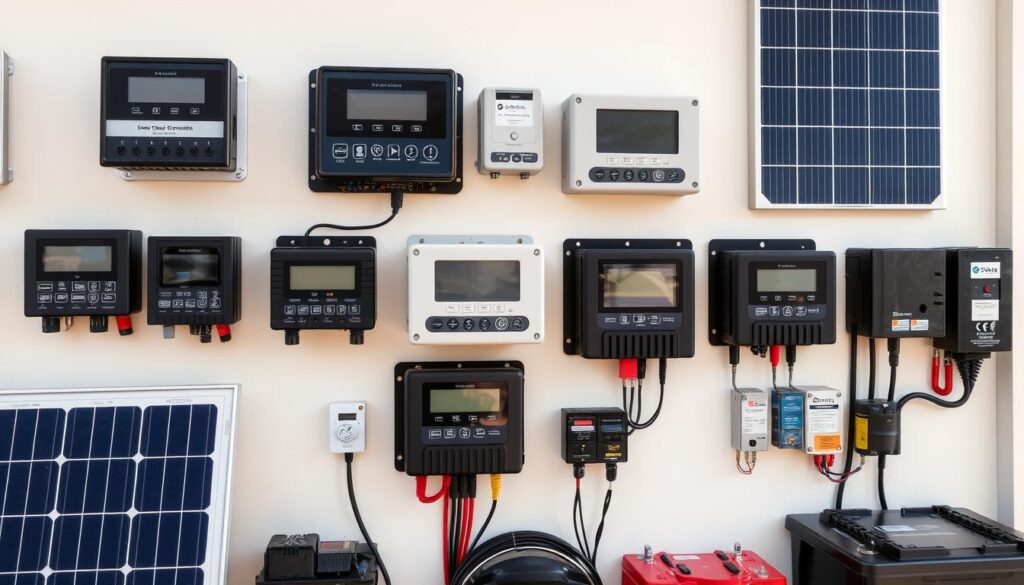
How to Configure Battery Disconnect Settings
Setting up battery disconnect settings is key for your solar system’s best performance. This guide will walk you through the steps. It also points out common mistakes and how to avoid them. This ensures your system works well and you get the most out of it.
Step-by-Step Configuration Process
- Gather Necessary Tools: Make sure you have a multimeter, the right wiring, and a charge controller manual.
- Shutdown Your System: Turn off your solar panel and disconnect any parts to avoid electric shock.
- Connect the Charge Controller: Check your manual for how to wire the solar array and battery correctly.
- Configure Settings: Use the charge controller’s programming to set the right voltage and parameters for your battery.
- Test the Configuration: Reconnect the system, turn it on, and check the voltage output to make sure it’s working right.
Common Configuration Mistakes
Setting up battery disconnect settings can be tricky. Knowing the common mistakes can help you avoid them.
- Incorrect Wiring: Double-check all connections between the solar array and battery; wrong wiring can harm your system.
- Improper Voltage Settings: Make sure the charge controller fits your battery’s needs to avoid overcharging.
- Ignoring Manufacturer’s Instructions: Each part has its own rules—always read the manual.
By following this guide, you can set up your battery disconnect settings correctly. This will make your solar energy system run smoothly and efficiently.
Related: New Hampshire’s Solar Revolution: How to Access Free Panels Today!
Benefits of Proper Battery Management
Proper battery management is key for solar energy systems to work well. It makes deep-cycle batteries last longer and boosts energy efficiency. Regular checks and the right settings help integrate renewable energy smoothly, ensuring reliable power.
Enhanced Battery Life
Good battery management extends the life of deep-cycle batteries. Regular checks and maintenance catch problems early. This includes:
- Routine inspections to check battery health
- Keeping terminals clean to prevent corrosion
- Optimizing charge settings to avoid overcharging
These steps improve battery performance, cutting down on replacement needs. Better battery life helps both the individual and the environment.
Improved Energy Efficiency
Effective photovoltaic system maintenance boosts energy efficiency. A well-kept battery system stores and uses renewable energy well. The main benefits are:
- Maximized energy consumption efficiency
- Minimized energy loss during storage and retrieval
- Greater overall system reliability
Adjusting battery settings for deep-cycle batteries improves how well they work with renewable energy. This creates a more efficient energy system.
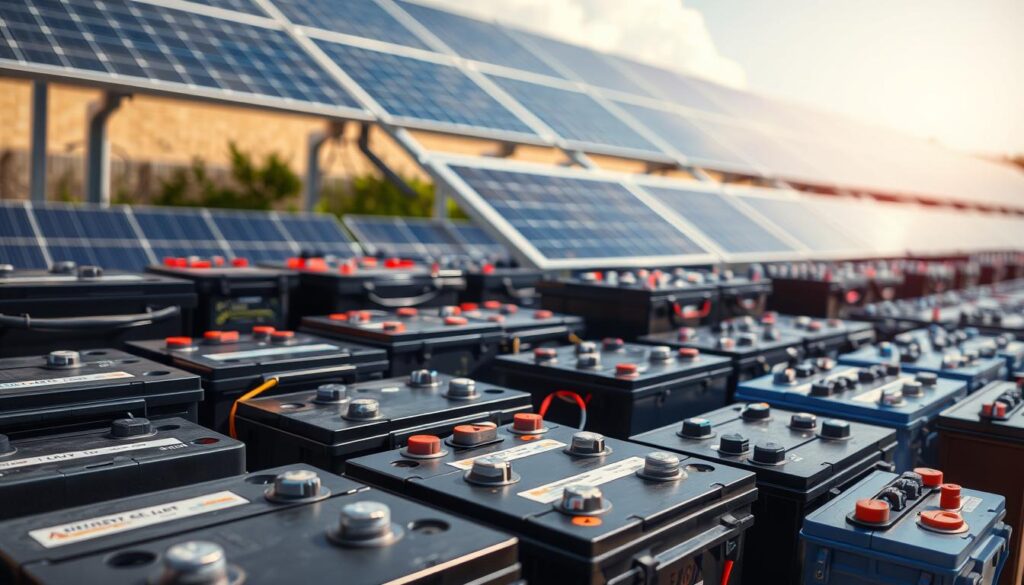
| Factor | Impact on Battery Life | Impact on Energy Efficiency |
|---|---|---|
| Regular Maintenance | Increases lifespan by identifying issues early | Ensures preferred operating conditions |
| Optimal Charging Settings | Prevents overcharging and damage | Reduces energy waste during charging |
| Battery Monitoring | Allows for timely repairs and adjustments | Improves overall power management |
Solar Charge Controllers: A Critical Element
Solar charge controllers are key in solar energy systems. They connect solar panels to battery banks. They control the voltage and current going into batteries, ensuring they charge right and don’t get overcharged. It’s crucial to program them well to get the most energy and keep batteries healthy.
These controllers can make batteries last longer by controlling how they charge. Many systems now let users set their options based on their energy needs. This makes the system work better and use energy more efficiently.
Keeping an eye on solar charge controllers is important for them to work well over time. Regular checks can spot problems early, keeping the whole solar system running smoothly. Having a maintenance schedule helps find issues, keeps the system going, and boosts energy output.
| Function | Importance in System |
|---|---|
| Regulates Battery Charge | Prevents Overcharging, Extends Battery Life |
| Maximizes Energy Harvest | Enhances Overall System Efficiency |
| Monitoring Voltage and Current | Ensures Safe Operation, Alerts for Maintenance |
| Programming Options | Customized Settings for Optimal Performance |
Battery Bank Configurations for Different Needs
It’s important to know about different battery bank setups to get the most out of energy storage. You can pick between series and parallel connections, each with its benefits. Series setups boost voltage but keep amp-hour capacity the same, perfect for high voltage needs. On the other hand, parallel setups increase amp-hour capacity, great for longer energy use.
A deep cycle battery bank is key for many energy storage needs. These batteries can handle being discharged and recharged many times. This makes them great for renewable energy systems. It’s important to size the deep cycle battery bank based on how much energy you use to avoid running out during busy times.
Efficient solar array wiring is also crucial for custom energy solutions. Well-wired solar arrays can boost energy production and improve system performance. When setting up solar array wiring, think about load demands, location, and sunlight to find the best setup.
| Configuration Type | Voltage Output | Amp-Hour Capacity | Best Use Cases |
|---|---|---|---|
| Series | Higher Voltage | Same as individual batteries | High voltage systems (e.g., off-grid homes) |
| Parallel | Same Voltage | Increased total capacity | Longer backup times (e.g., emergency power supply) |
Choosing the right battery bank setup is key for better energy efficiency. It also helps users make their systems work well for off-grid or grid-tied situations.
Off-grid power Systems and Battery Disconnects
Off-grid power systems work on their own, away from the usual energy grid. This lets people live sustainably and control their energy. Knowing how to use battery disconnects is key for managing energy well and keeping systems safe.
How Off-Grid Systems Function
Off-grid systems use solar panels to make electricity. They store energy in batteries for when it’s dark. This setup lets people use energy in places far from the grid, relying more on nature.
They also have grid-tie inverters. This means users can connect to the grid later if they want.
Setting Up Disconnects in Off-Grid Configurations
Setting up battery disconnects right is crucial for off-grid systems. Here’s what to do:
- Use manual switches to cut off the battery bank during upkeep.
- Put in automatic devices that stop the battery from overcharging or running low.
- Make sure disconnect switches are clearly labeled to avoid mistakes in emergencies.
- Test disconnects often to make sure they work right and keep systems safe.
By doing these things, users can manage their off-grid systems well. This ensures they work great and stay safe.
Safety Measures for Battery Disconnects
Keeping solar energy systems safe is key. The right solar panel setup helps avoid short circuits and battery problems. Here are important safety steps to take:
- Use the right wire size to handle the current well.
- Choose top-notch disconnect parts made for solar use.
- Have fail-safes and backups ready for when things go wrong.
- Make sure batteries have good airflow to avoid overheating.
- Check all connections and parts often as part of keeping systems running smoothly.
By following these tips, you protect your gear and keep people safe. Being proactive helps your solar setup last longer and work better.
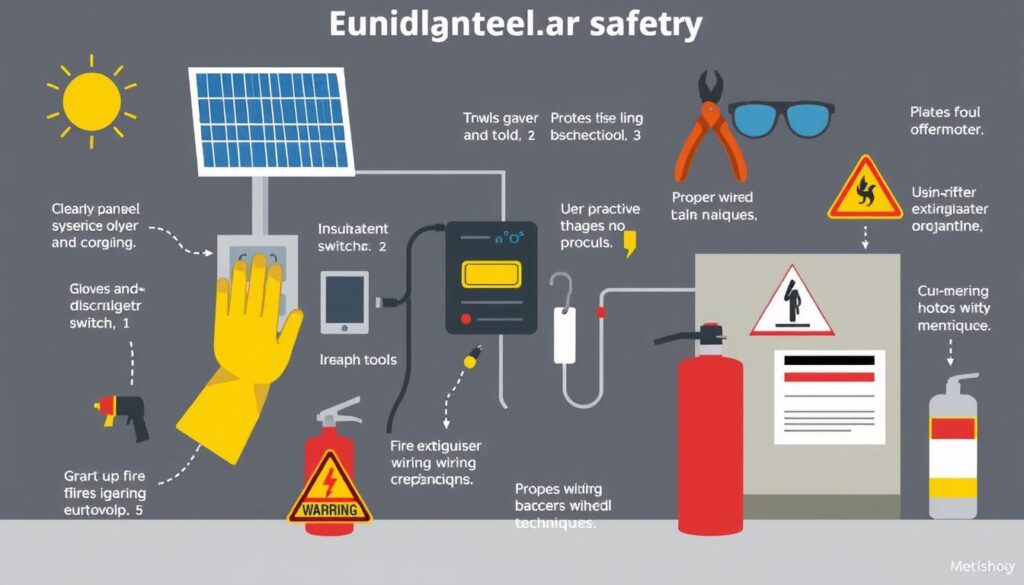
| Safety Measure | Description | Benefits |
|---|---|---|
| Wire Gauge | Choosing the correct gauge to fit the current rating | Prevents overheating and fire hazards |
| Disconnect Hardware | Using reliable and compatible disconnect switches | Ensures safe isolation of the battery during maintenance |
| Fail-safes | Implementing backups for critical components | Minimizes risk of system failure |
| Ventilation | Allowing airflow around battery systems | Reduces risk of thermal runaway |
| Regular Inspections | Conducting routine evaluations of the system | Identifies potential issues before they escalate |
Conclusion
Solar panel battery disconnect settings are crucial for better performance and safety in renewable energy systems. They help optimize energy storage, extend battery life, and boost efficiency. Whether you’re experienced or new, knowing these settings is important.
Choosing wisely for your solar and battery management can greatly improve your setup. Regularly check your system to ensure it’s working at its best. This is key for getting the most out of your energy storage.
Being proactive with your solar panel battery settings keeps your system safe and efficient. It also makes sure you get the most from your renewable energy investment. Stay committed to improving and enjoy reliable power for your home.
FAQ
What is a battery disconnect with solar panel settings?
A battery disconnect is a safety feature. It isolates the battery from the solar system. It’s important for maintenance and protecting the system from damage.
How do I determine the right battery disconnect settings for my solar panel system?
The right settings depend on several factors. These include the battery type, solar array size, and energy needs. Check your solar charge controller’s manual for the correct settings.
When should I disconnect my batteries from the solar panel system?
Disconnect batteries during maintenance or emergencies. Also, do it if wethe ather is bad or if the system will be idle for a long time.
What are the battery safety measures I should be aware of?
Important safety steps include using the right wire gauge and installing disconnect hardware correctly. Regularly check for wear or damage to ensure safe operation.
How do I configure the battery disconnect settings correctly?
To set up the disconnect settings, start by identifying the right tools. Then, follow the manufacturer’s guidelines and test the setup. Avoid common mistakes to ensure correct installation.
What benefits does proper battery management provide?
Proper management extends battery life and boosts energy efficiency. It also reduces replacement needs. These practices save money and ensure optimal system performance over time.
What are solar charge controllers, and why are they important?
Solar charge controllers prevent overcharging and damage. They are key to maintaining battery health and maximizing system efficiency.
How can I customize my battery bank configuration for off-grid power needs?
Customize your battery bank by choosing the right battery type and size. Decide on series or parallel connections based on your energy needs.
Why is it crucial to monitor my solar energy system regularly?
Regular monitoring ensures all parts, like battery disconnects, work right. This helps catch issues early, keeping the system reliable and safe.
What role does renewable energy integration play in battery disconnect settings?
Renewable energy integration boosts solar system performance. Proper battery disconnect settings manage energy flow efficiently. This ensures a constant power supply and extends system life.
